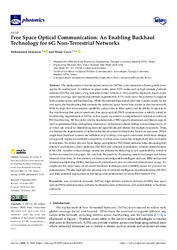Free space optical communication: An enabling backhaul technology for 6G non-terrestrial networks
| dc.contributor.author | Elamassie, Mohammed | |
| dc.contributor.author | Uysal, Murat | |
| dc.date.accessioned | 2024-01-29T12:22:03Z | |
| dc.date.available | 2024-01-29T12:22:03Z | |
| dc.date.issued | 2023-11 | |
| dc.identifier.issn | 2304-6732 | en_US |
| dc.identifier.uri | http://hdl.handle.net/10679/9113 | |
| dc.identifier.uri | https://www.mdpi.com/2304-6732/10/11/1210 | |
| dc.description.abstract | The deployment of non-terrestrial networks (NTNs) is envisioned to achieve global coverage for 6G and beyond. In addition to space nodes, aerial NTN nodes such as high-altitude platform stations (HAPSs) and rotary-wing unmanned aerial vehicles (UAVs) could be deployed, based on the intended coverage and operational altitude requirements. NTN nodes have the potential to support both wireless access and backhauling. While the onboard base station provides wireless access for the end users, the backhauling link connects the airborne/space-borne base station to the core network. With its high data transmission capability comparable to fiber optics and its ability to operate in the interference-free optical spectrum, free space optical (FSO) communication is ideally suited to backhauling requirements in NTNs. In this paper, we present a comprehensive tutorial on airborne FSO backhauling. We first delve into the fundamentals of FSO signal transmission and discuss aspects such as geometrical loss, atmospheric attenuation, turbulence-induced fading, and pointing errors, all of which are critical for determining received signal levels and related link budget calculations. Then, we discuss the requirements of airborne backhaul system architectures, based on use cases. While single-layer backhaul systems are sufficient for providing coverage in rural areas, multi-layer designs are typically required to establish connectivity in urban areas, where line of sight (LoS) links are harder to maintain. We review physical layer design principles for FSO-based airborne links, discussing both intensity modulation/direct detection (IM/DD) and coherent modulation/coherent demodulation (CM/CD). Another critical design criteria for airborne backhauling is self-sustainability, which is further discussed in our paper. We conclude the paper by discussing current challenges and future research directions. In this context, we discuss reconfigurable intelligent surfaces (RIS) and spatial division multiplexing (SDM), for improved performance and an extended transmission range. We emphasize the importance of advanced handover techniques and scalability issues for practical implementation. We also highlight the growing role of artificial intelligence/machine learning (AI/ML) and their potential applications in the design and optimization of future FSO-based NTNs. | en_US |
| dc.description.sponsorship | TÜBİTAK | |
| dc.language.iso | eng | en_US |
| dc.publisher | MDPI | en_US |
| dc.relation | info:turkey/grantAgreement/TUBITAK/120E312 | |
| dc.relation.ispartof | Photonics | |
| dc.rights | openAccess | |
| dc.rights | Attribution 4.0 International | |
| dc.rights.uri | https://creativecommons.org/licenses/by/4.0/ | |
| dc.title | Free space optical communication: An enabling backhaul technology for 6G non-terrestrial networks | en_US |
| dc.type | Article | en_US |
| dc.description.version | Publisher version | en_US |
| dc.peerreviewed | yes | en_US |
| dc.publicationstatus | Published | en_US |
| dc.contributor.department | Özyeğin University | |
| dc.contributor.authorID | (ORCID 0000-0001-9416-3860 & YÖK ID 325395) Elamassie, Mohammed | |
| dc.contributor.authorID | (ORCID 0000-0001-5945-0813 & YÖK ID 124615) Uysal, Murat | |
| dc.contributor.ozuauthor | Elamassie, Mohammed | |
| dc.contributor.ozuauthor | Uysal, Murat | |
| dc.identifier.volume | 10 | en_US |
| dc.identifier.issue | 11 | en_US |
| dc.identifier.wos | WOS:001115380300001 | |
| dc.identifier.doi | 10.3390/photonics10111210 | en_US |
| dc.subject.keywords | Airborne backhaul system architectures | en_US |
| dc.subject.keywords | Free space optical (FSO) communication | en_US |
| dc.subject.keywords | High-altitude platform stations (HAPS) | en_US |
| dc.subject.keywords | Non-terrestrial networks (NTNs) | en_US |
| dc.subject.keywords | Self-sustainability in backhaul networks | en_US |
| dc.identifier.scopus | SCOPUS:2-s2.0-85178116820 | |
| dc.relation.publicationcategory | Article - International Refereed Journal - Institutional Academic Staff |
Files in this item
This item appears in the following Collection(s)
Share this page




